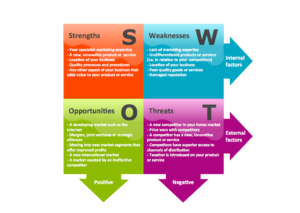What is a SWOT Analysis?
A SWOT analysis is a strategic planning tool used by individuals and businesses to identify Strengths, Weaknesses, Opportunities, and Threats. This simple yet effective framework helps in decision-making, problem-solving, and long-term planning.
Why is a SWOT Analysis Important?
A SWOT analysis provides a clear snapshot of an organization’s internal and external environment. It helps in:
- Identifying competitive advantages
- Recognizing areas for improvement
- Spotting new growth opportunities
- Preparing for potential risks
Free SWOT Analysis Template Download
We have created a free, easy-to-use SWOT analysis template that you can download and customize according to your needs.
[Download the Free SWOT Analysis Template Here]
How to Conduct a SWOT Analysis: Step-by-Step Guide
Step 1: Define Your Objective
Before conducting a SWOT analysis, determine the specific goal you want to achieve. It could be for a business strategy, project assessment, or personal development.
Step 2: Gather Key Information
Collect relevant data about your business or project, such as market trends, competitor analysis, and internal performance metrics.
Step 3: Fill in the SWOT Matrix
Use the template to list out the following:
Strengths (Internal Factors)
These are the positive attributes of your business or project.
- What do you do well?
- What unique resources do you have?
- What are your competitive advantages?
Weaknesses (Internal Factors)
These are areas where you may need improvement.
- What areas need enhancement?
- What resources are lacking?
- Where do competitors have an advantage over you?
Opportunities (External Factors)
These are favorable external conditions that could benefit you.
- Are there market trends you can leverage?
- Is there demand for your product/service?
- Are there new partnerships or markets available?
Threats (External Factors)
These are external risks that could impact you negatively.
- What challenges do you face in the market?
- Are there economic or regulatory concerns?
- Is there strong competition?
Step 4: Analyze and Prioritize Findings
Review your completed SWOT analysis and prioritize the most critical points. Develop strategies to maximize strengths, improve weaknesses, seize opportunities, and mitigate threats.
Step 5: Create an Action Plan
Based on your analysis, create an action plan that outlines the next steps, assigns responsibilities, and sets deadlines for implementation.

SWOT Analysis Report on Finance
Strengths:
- Strong financial reserves and cash flow
- Good credit rating and access to capital
- Established financial management practices
- Effective cost-control measures
Weaknesses:
- High operational costs
- Dependence on external funding
- Limited diversification of revenue streams
- Inefficient budget allocation
Opportunities:
- Expansion into new financial markets
- Technological advancements in fintech solutions
- Favorable economic policies and regulations
- Investment opportunities in emerging sectors
Threats:
- Market volatility and economic downturns
- Increasing regulatory requirements
- Cybersecurity risks and data breaches
- Rising competition in financial services
Tips for an Effective SWOT Analysis
- Be Honest: Provide realistic and objective insights.
- Stay Focused: Keep your analysis aligned with your goals.
- Use Data: Support points with factual information.
- Keep it Simple: Avoid overcomplicating the analysis.
Final Thoughts
A SWOT analysis is a valuable tool that helps businesses and individuals make informed decisions. Download our free template to start analyzing your strengths, weaknesses, opportunities, and threats today!











